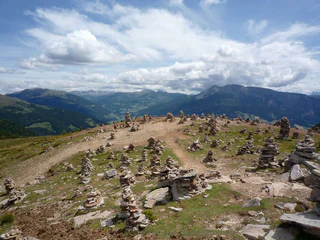
1/2
Campitello - Men of Stones
Vallesina/Versein, Mölten/Meltina, Bolzano/Bozen and environs
Whether you're interested in the breathtaking Stilfser Joch National Park, the UNESCO World Heritage Dolomites, or the secluded Pfunderer Berge mountains, the region's high-altitude and long-distance hiking trails provide an opportunity for multi-day hikes that take you through stunning landscapes from one mountain hut to another. These extended hikes in the mountains offer an ideal escape from the demands of everyday life, allowing you to truly disconnect and immerse yourself in nature.

1/2
Vallesina/Versein, Mölten/Meltina, Bolzano/Bozen and environs

Alpe di Rodengo/Rodenecker Alm, Rodeneck/Rodengo

1/5
Slingia/Schlinig, Mals/Malles, Vinschgau/Val Venosta

1/5
Ortisei/Urtijëi/St. Ulrich/Urtijëi, Urtijëi/Ortisei, Dolomites Region Val Gardena

Tesido/Taisten, Welsberg-Taisten/Monguelfo-Tesido

1/4
Radein/Redagno, Aldein/Aldino

Oris/Eyrs, Laas/Lasa, Vinschgau/Val Venosta

1/2
San Vigilio

1/4
Nobls/Nobls, Jenesien/San Genesio Atesino, Bolzano/Bozen and environs

1/3
Velloi/Vellau, Algund/Lagundo, Meran/Merano and environs

Pochi/Buchholz, Salorno/Salurn, Alto Adige Wine Road

Ortisei/Urtijëi/St. Ulrich/Urtijëi, Urtijëi/Ortisei, Dolomites Region Val Gardena

1/5
Tubre/Taufers i. M., Mals/Malles, Vinschgau/Val Venosta

S. Martino/St. Martin - Casies/Gsies, Gsies/Valle di Casies

1/2
Falzeben/Falzeben, Hafling/Avelengo, Meran/Merano and environs

1/4
Clusio/Schleis, Mals/Malles, Vinschgau/Val Venosta

Planol/Planeil, Mals/Malles, Vinschgau/Val Venosta

Redagno/Radein, Aldein/Aldino

Anterselva di Mezzo/Antholz-Mittertal, Rasen-Antholz/Rasun Anterselva, Dolomites Region Kronplatz/Plan de Corones

1/10
Montesole/Sonnenberg - Parcines/Partschins, Partschins/Parcines, Meran/Merano and environs

1/9
Trodena/Truden, Truden/Trodena

Laghetti/Laag, Neumarkt/Egna, Alto Adige Wine Road

Redagno/Radein, Aldein/Aldino

1/4

1/2
Radein/Redagno, Aldein/Aldino

1/2
Nova Ponente Centro/Deutschnofen Dorf, Karneid/Cornedo all'Isarco, Dolomites Region Eggental

1/4
Vellau/Velloi, Algund/Lagundo, Meran/Merano and environs

Anterivo/Altrei, Altrei/Anterivo

1/2
Obereggen/Obereggen, Deutschnofen/Nova Ponente, Dolomites Region Eggental

Anterivo/Altrei, Altrei/Anterivo